Torts in Business Situations
VerifiedAdded on 2020/03/01
|10
|2605
|40
AI Summary
This assignment analyzes the significance of negligence and misrepresentation laws within business contexts. It examines how these legal principles apply to various scenarios, emphasizing the importance of understanding tort law components for businesses to avoid potential harm. Additionally, the assignment discusses the role of public authorities in mitigating tortious wrongs and protecting stakeholder interests.
Contribute Materials
Your contribution can guide someone’s learning journey. Share your
documents today.
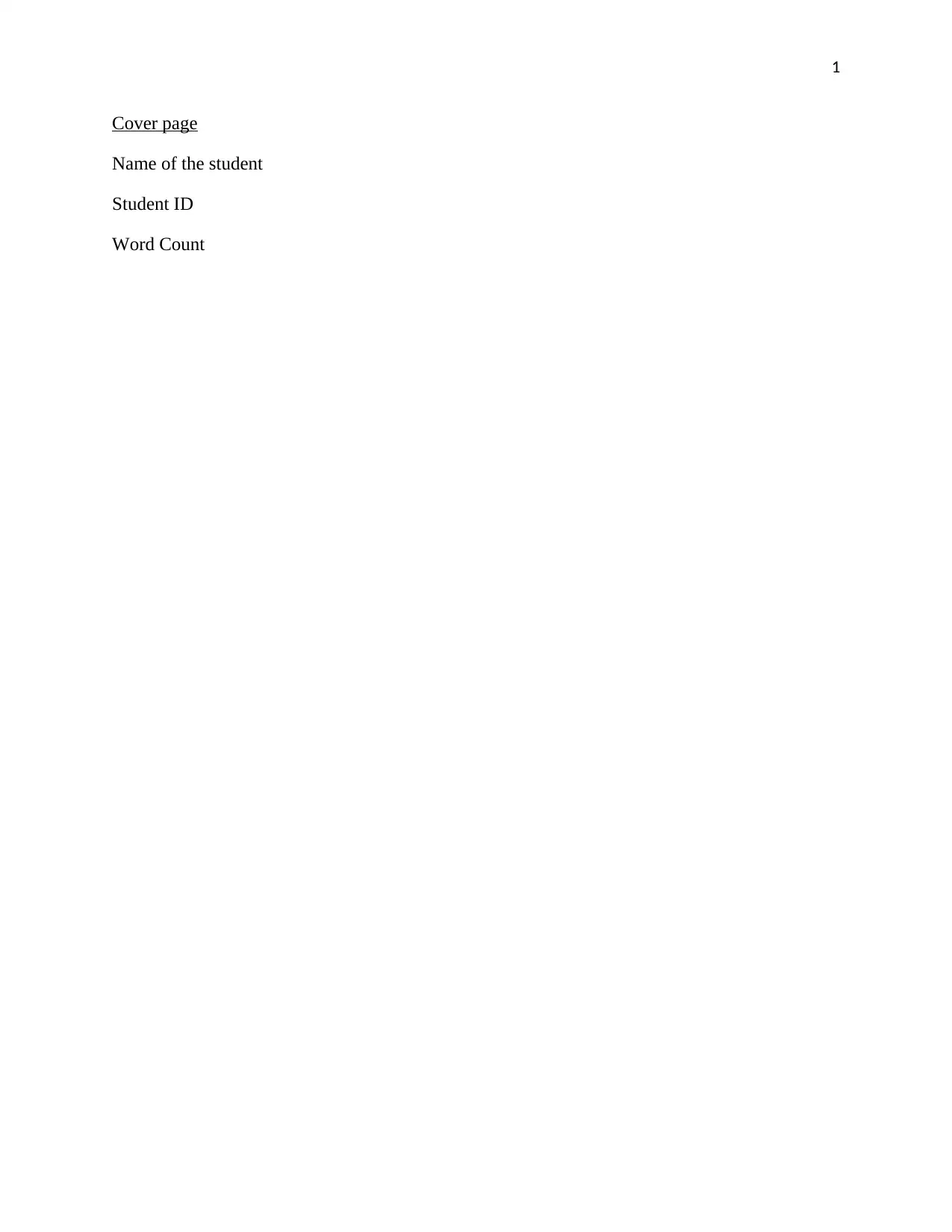
1
Cover page
Name of the student
Student ID
Word Count
Cover page
Name of the student
Student ID
Word Count
Secure Best Marks with AI Grader
Need help grading? Try our AI Grader for instant feedback on your assignments.
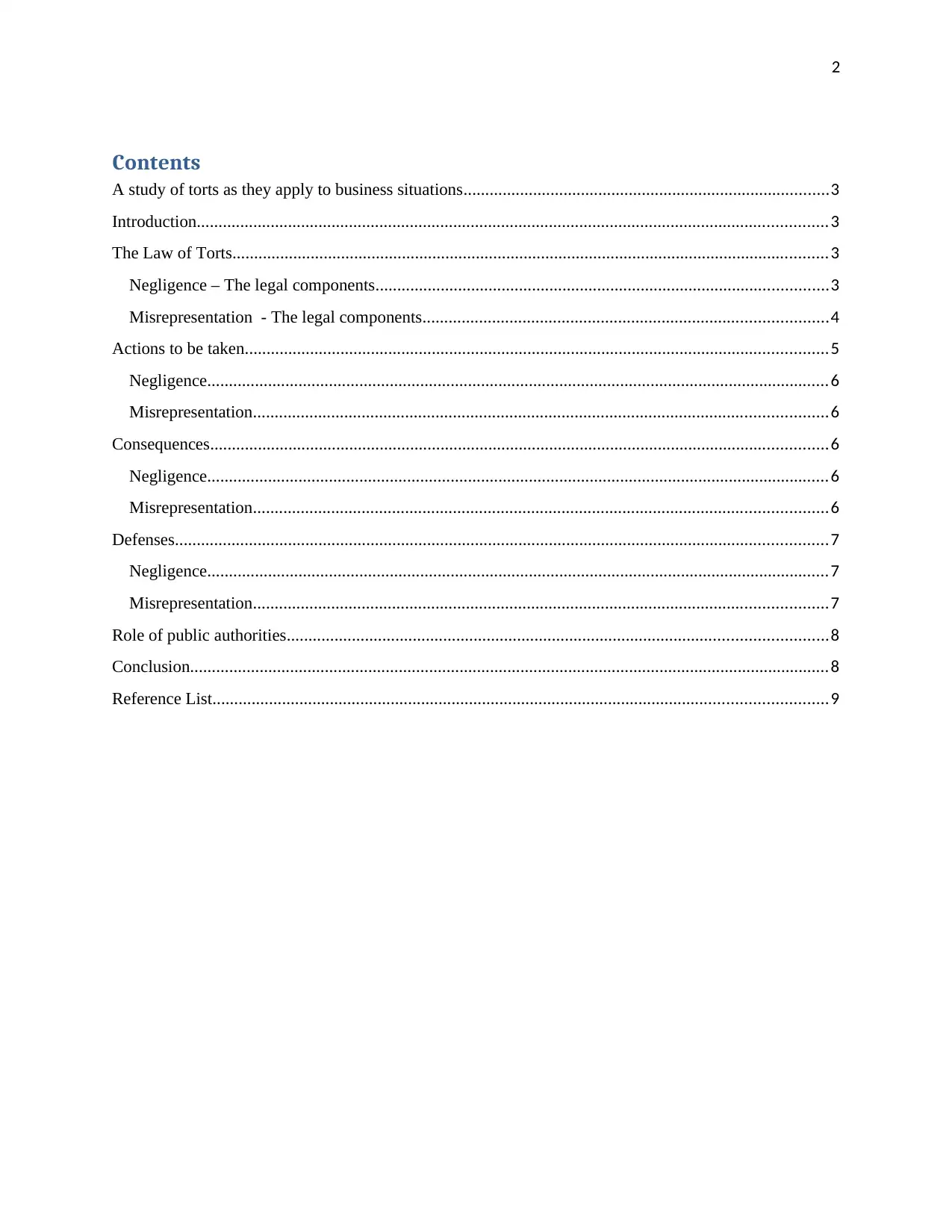
2
Contents
A study of torts as they apply to business situations....................................................................................3
Introduction.................................................................................................................................................3
The Law of Torts.........................................................................................................................................3
Negligence – The legal components........................................................................................................3
Misrepresentation - The legal components.............................................................................................4
Actions to be taken......................................................................................................................................5
Negligence...............................................................................................................................................6
Misrepresentation....................................................................................................................................6
Consequences..............................................................................................................................................6
Negligence...............................................................................................................................................6
Misrepresentation....................................................................................................................................6
Defenses......................................................................................................................................................7
Negligence...............................................................................................................................................7
Misrepresentation....................................................................................................................................7
Role of public authorities............................................................................................................................8
Conclusion...................................................................................................................................................8
Reference List.............................................................................................................................................9
Contents
A study of torts as they apply to business situations....................................................................................3
Introduction.................................................................................................................................................3
The Law of Torts.........................................................................................................................................3
Negligence – The legal components........................................................................................................3
Misrepresentation - The legal components.............................................................................................4
Actions to be taken......................................................................................................................................5
Negligence...............................................................................................................................................6
Misrepresentation....................................................................................................................................6
Consequences..............................................................................................................................................6
Negligence...............................................................................................................................................6
Misrepresentation....................................................................................................................................6
Defenses......................................................................................................................................................7
Negligence...............................................................................................................................................7
Misrepresentation....................................................................................................................................7
Role of public authorities............................................................................................................................8
Conclusion...................................................................................................................................................8
Reference List.............................................................................................................................................9
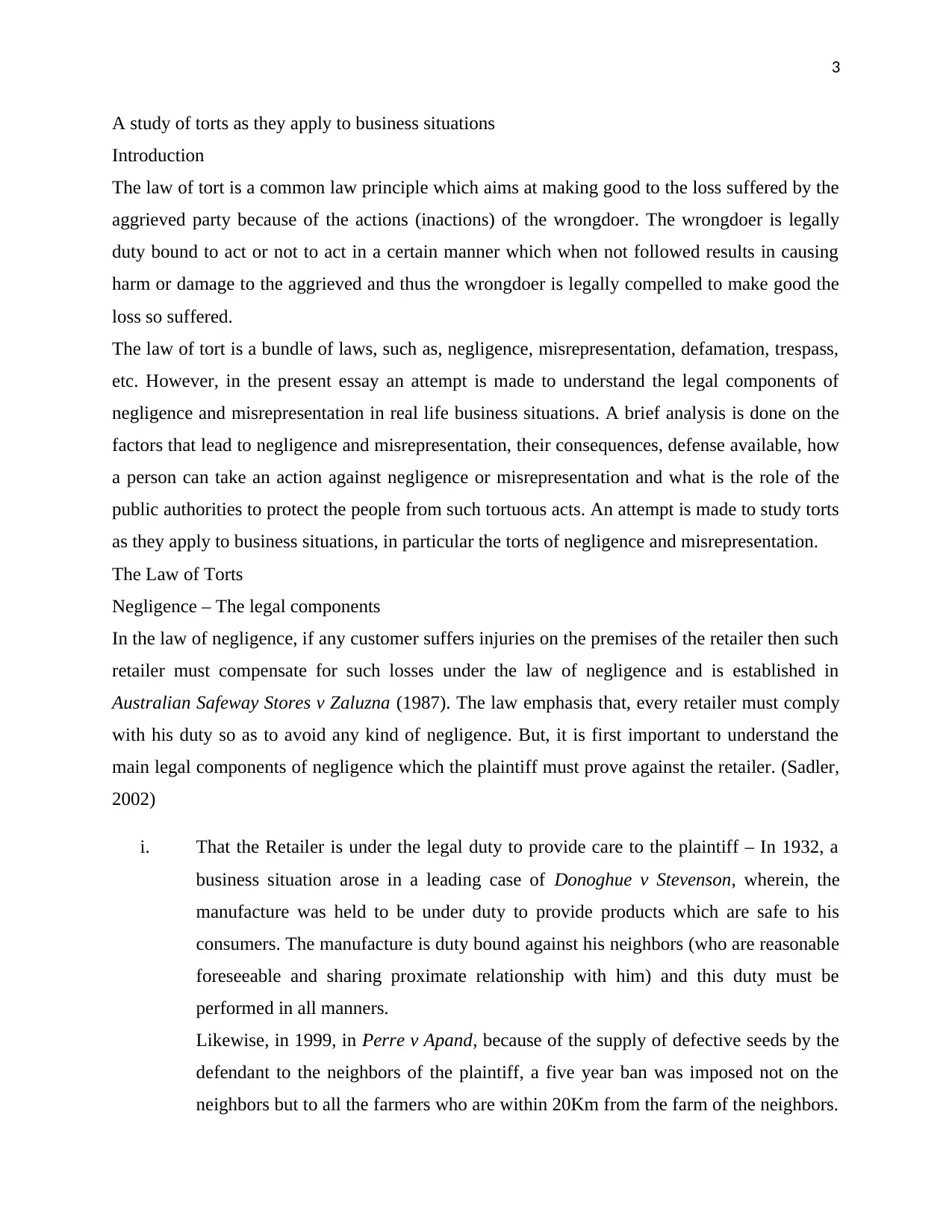
3
A study of torts as they apply to business situations
Introduction
The law of tort is a common law principle which aims at making good to the loss suffered by the
aggrieved party because of the actions (inactions) of the wrongdoer. The wrongdoer is legally
duty bound to act or not to act in a certain manner which when not followed results in causing
harm or damage to the aggrieved and thus the wrongdoer is legally compelled to make good the
loss so suffered.
The law of tort is a bundle of laws, such as, negligence, misrepresentation, defamation, trespass,
etc. However, in the present essay an attempt is made to understand the legal components of
negligence and misrepresentation in real life business situations. A brief analysis is done on the
factors that lead to negligence and misrepresentation, their consequences, defense available, how
a person can take an action against negligence or misrepresentation and what is the role of the
public authorities to protect the people from such tortuous acts. An attempt is made to study torts
as they apply to business situations, in particular the torts of negligence and misrepresentation.
The Law of Torts
Negligence – The legal components
In the law of negligence, if any customer suffers injuries on the premises of the retailer then such
retailer must compensate for such losses under the law of negligence and is established in
Australian Safeway Stores v Zaluzna (1987). The law emphasis that, every retailer must comply
with his duty so as to avoid any kind of negligence. But, it is first important to understand the
main legal components of negligence which the plaintiff must prove against the retailer. (Sadler,
2002)
i. That the Retailer is under the legal duty to provide care to the plaintiff – In 1932, a
business situation arose in a leading case of Donoghue v Stevenson, wherein, the
manufacture was held to be under duty to provide products which are safe to his
consumers. The manufacture is duty bound against his neighbors (who are reasonable
foreseeable and sharing proximate relationship with him) and this duty must be
performed in all manners.
Likewise, in 1999, in Perre v Apand, because of the supply of defective seeds by the
defendant to the neighbors of the plaintiff, a five year ban was imposed not on the
neighbors but to all the farmers who are within 20Km from the farm of the neighbors.
A study of torts as they apply to business situations
Introduction
The law of tort is a common law principle which aims at making good to the loss suffered by the
aggrieved party because of the actions (inactions) of the wrongdoer. The wrongdoer is legally
duty bound to act or not to act in a certain manner which when not followed results in causing
harm or damage to the aggrieved and thus the wrongdoer is legally compelled to make good the
loss so suffered.
The law of tort is a bundle of laws, such as, negligence, misrepresentation, defamation, trespass,
etc. However, in the present essay an attempt is made to understand the legal components of
negligence and misrepresentation in real life business situations. A brief analysis is done on the
factors that lead to negligence and misrepresentation, their consequences, defense available, how
a person can take an action against negligence or misrepresentation and what is the role of the
public authorities to protect the people from such tortuous acts. An attempt is made to study torts
as they apply to business situations, in particular the torts of negligence and misrepresentation.
The Law of Torts
Negligence – The legal components
In the law of negligence, if any customer suffers injuries on the premises of the retailer then such
retailer must compensate for such losses under the law of negligence and is established in
Australian Safeway Stores v Zaluzna (1987). The law emphasis that, every retailer must comply
with his duty so as to avoid any kind of negligence. But, it is first important to understand the
main legal components of negligence which the plaintiff must prove against the retailer. (Sadler,
2002)
i. That the Retailer is under the legal duty to provide care to the plaintiff – In 1932, a
business situation arose in a leading case of Donoghue v Stevenson, wherein, the
manufacture was held to be under duty to provide products which are safe to his
consumers. The manufacture is duty bound against his neighbors (who are reasonable
foreseeable and sharing proximate relationship with him) and this duty must be
performed in all manners.
Likewise, in 1999, in Perre v Apand, because of the supply of defective seeds by the
defendant to the neighbors of the plaintiff, a five year ban was imposed not on the
neighbors but to all the farmers who are within 20Km from the farm of the neighbors.
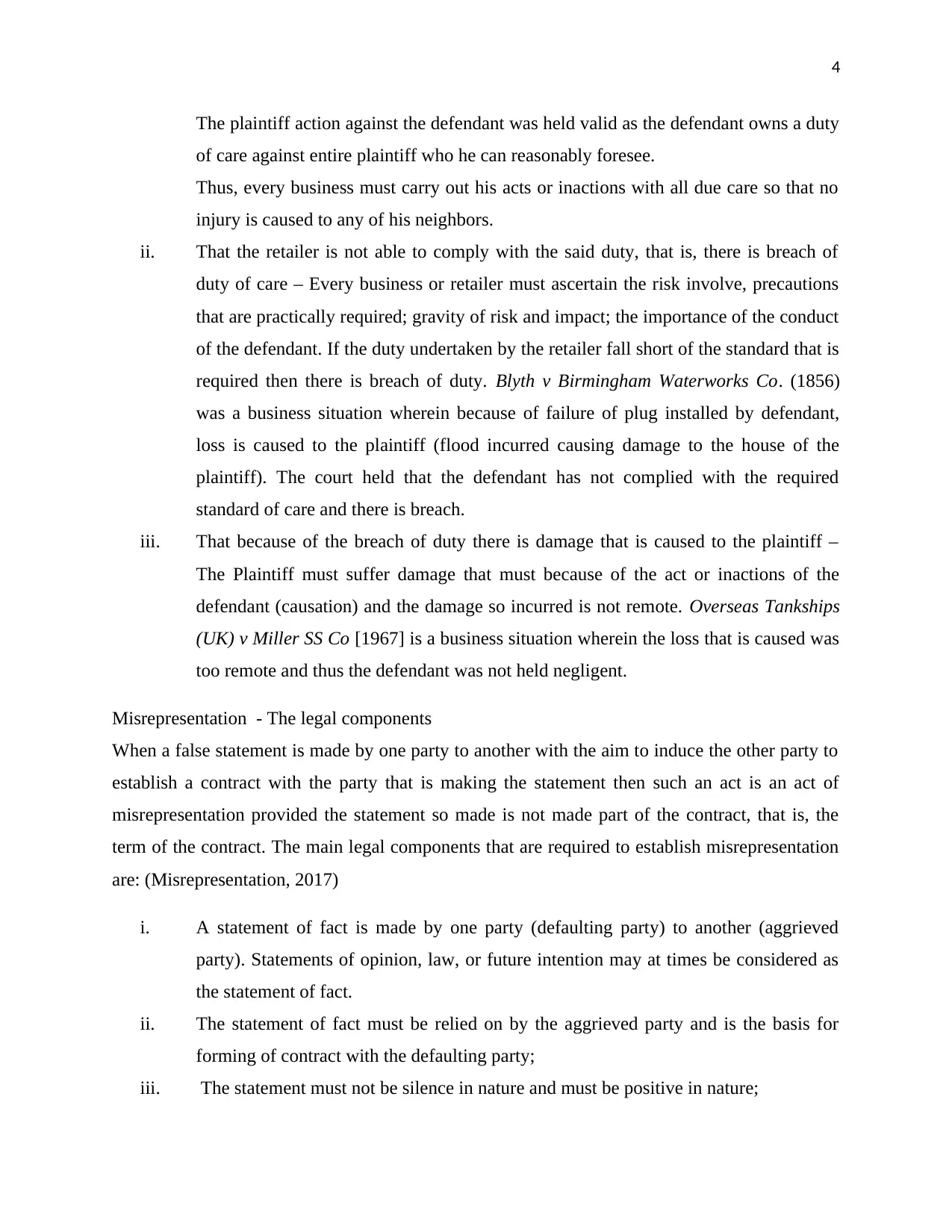
4
The plaintiff action against the defendant was held valid as the defendant owns a duty
of care against entire plaintiff who he can reasonably foresee.
Thus, every business must carry out his acts or inactions with all due care so that no
injury is caused to any of his neighbors.
ii. That the retailer is not able to comply with the said duty, that is, there is breach of
duty of care – Every business or retailer must ascertain the risk involve, precautions
that are practically required; gravity of risk and impact; the importance of the conduct
of the defendant. If the duty undertaken by the retailer fall short of the standard that is
required then there is breach of duty. Blyth v Birmingham Waterworks Co. (1856)
was a business situation wherein because of failure of plug installed by defendant,
loss is caused to the plaintiff (flood incurred causing damage to the house of the
plaintiff). The court held that the defendant has not complied with the required
standard of care and there is breach.
iii. That because of the breach of duty there is damage that is caused to the plaintiff –
The Plaintiff must suffer damage that must because of the act or inactions of the
defendant (causation) and the damage so incurred is not remote. Overseas Tankships
(UK) v Miller SS Co [1967] is a business situation wherein the loss that is caused was
too remote and thus the defendant was not held negligent.
Misrepresentation - The legal components
When a false statement is made by one party to another with the aim to induce the other party to
establish a contract with the party that is making the statement then such an act is an act of
misrepresentation provided the statement so made is not made part of the contract, that is, the
term of the contract. The main legal components that are required to establish misrepresentation
are: (Misrepresentation, 2017)
i. A statement of fact is made by one party (defaulting party) to another (aggrieved
party). Statements of opinion, law, or future intention may at times be considered as
the statement of fact.
ii. The statement of fact must be relied on by the aggrieved party and is the basis for
forming of contract with the defaulting party;
iii. The statement must not be silence in nature and must be positive in nature;
The plaintiff action against the defendant was held valid as the defendant owns a duty
of care against entire plaintiff who he can reasonably foresee.
Thus, every business must carry out his acts or inactions with all due care so that no
injury is caused to any of his neighbors.
ii. That the retailer is not able to comply with the said duty, that is, there is breach of
duty of care – Every business or retailer must ascertain the risk involve, precautions
that are practically required; gravity of risk and impact; the importance of the conduct
of the defendant. If the duty undertaken by the retailer fall short of the standard that is
required then there is breach of duty. Blyth v Birmingham Waterworks Co. (1856)
was a business situation wherein because of failure of plug installed by defendant,
loss is caused to the plaintiff (flood incurred causing damage to the house of the
plaintiff). The court held that the defendant has not complied with the required
standard of care and there is breach.
iii. That because of the breach of duty there is damage that is caused to the plaintiff –
The Plaintiff must suffer damage that must because of the act or inactions of the
defendant (causation) and the damage so incurred is not remote. Overseas Tankships
(UK) v Miller SS Co [1967] is a business situation wherein the loss that is caused was
too remote and thus the defendant was not held negligent.
Misrepresentation - The legal components
When a false statement is made by one party to another with the aim to induce the other party to
establish a contract with the party that is making the statement then such an act is an act of
misrepresentation provided the statement so made is not made part of the contract, that is, the
term of the contract. The main legal components that are required to establish misrepresentation
are: (Misrepresentation, 2017)
i. A statement of fact is made by one party (defaulting party) to another (aggrieved
party). Statements of opinion, law, or future intention may at times be considered as
the statement of fact.
ii. The statement of fact must be relied on by the aggrieved party and is the basis for
forming of contract with the defaulting party;
iii. The statement must not be silence in nature and must be positive in nature;
Secure Best Marks with AI Grader
Need help grading? Try our AI Grader for instant feedback on your assignments.
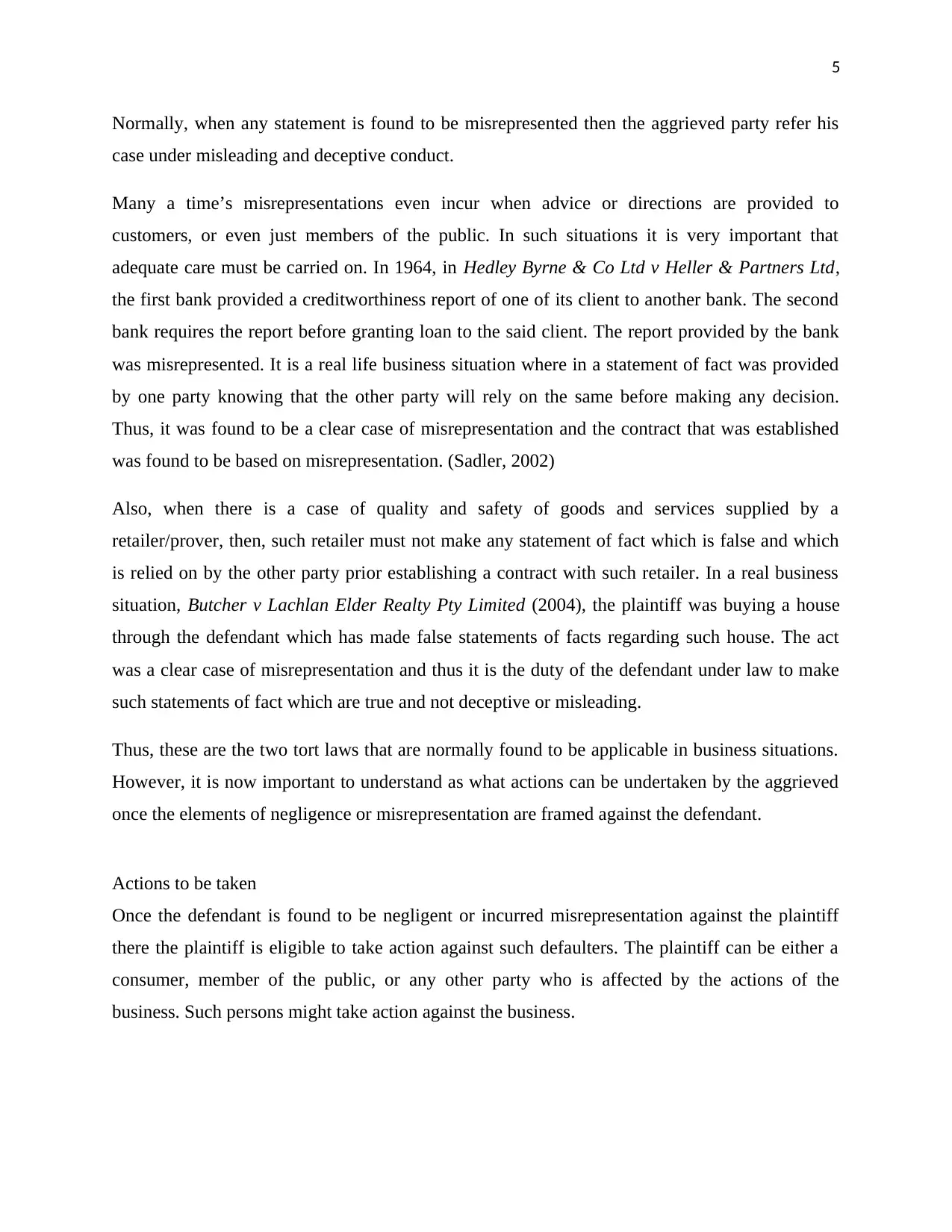
5
Normally, when any statement is found to be misrepresented then the aggrieved party refer his
case under misleading and deceptive conduct.
Many a time’s misrepresentations even incur when advice or directions are provided to
customers, or even just members of the public. In such situations it is very important that
adequate care must be carried on. In 1964, in Hedley Byrne & Co Ltd v Heller & Partners Ltd,
the first bank provided a creditworthiness report of one of its client to another bank. The second
bank requires the report before granting loan to the said client. The report provided by the bank
was misrepresented. It is a real life business situation where in a statement of fact was provided
by one party knowing that the other party will rely on the same before making any decision.
Thus, it was found to be a clear case of misrepresentation and the contract that was established
was found to be based on misrepresentation. (Sadler, 2002)
Also, when there is a case of quality and safety of goods and services supplied by a
retailer/prover, then, such retailer must not make any statement of fact which is false and which
is relied on by the other party prior establishing a contract with such retailer. In a real business
situation, Butcher v Lachlan Elder Realty Pty Limited (2004), the plaintiff was buying a house
through the defendant which has made false statements of facts regarding such house. The act
was a clear case of misrepresentation and thus it is the duty of the defendant under law to make
such statements of fact which are true and not deceptive or misleading.
Thus, these are the two tort laws that are normally found to be applicable in business situations.
However, it is now important to understand as what actions can be undertaken by the aggrieved
once the elements of negligence or misrepresentation are framed against the defendant.
Actions to be taken
Once the defendant is found to be negligent or incurred misrepresentation against the plaintiff
there the plaintiff is eligible to take action against such defaulters. The plaintiff can be either a
consumer, member of the public, or any other party who is affected by the actions of the
business. Such persons might take action against the business.
Normally, when any statement is found to be misrepresented then the aggrieved party refer his
case under misleading and deceptive conduct.
Many a time’s misrepresentations even incur when advice or directions are provided to
customers, or even just members of the public. In such situations it is very important that
adequate care must be carried on. In 1964, in Hedley Byrne & Co Ltd v Heller & Partners Ltd,
the first bank provided a creditworthiness report of one of its client to another bank. The second
bank requires the report before granting loan to the said client. The report provided by the bank
was misrepresented. It is a real life business situation where in a statement of fact was provided
by one party knowing that the other party will rely on the same before making any decision.
Thus, it was found to be a clear case of misrepresentation and the contract that was established
was found to be based on misrepresentation. (Sadler, 2002)
Also, when there is a case of quality and safety of goods and services supplied by a
retailer/prover, then, such retailer must not make any statement of fact which is false and which
is relied on by the other party prior establishing a contract with such retailer. In a real business
situation, Butcher v Lachlan Elder Realty Pty Limited (2004), the plaintiff was buying a house
through the defendant which has made false statements of facts regarding such house. The act
was a clear case of misrepresentation and thus it is the duty of the defendant under law to make
such statements of fact which are true and not deceptive or misleading.
Thus, these are the two tort laws that are normally found to be applicable in business situations.
However, it is now important to understand as what actions can be undertaken by the aggrieved
once the elements of negligence or misrepresentation are framed against the defendant.
Actions to be taken
Once the defendant is found to be negligent or incurred misrepresentation against the plaintiff
there the plaintiff is eligible to take action against such defaulters. The plaintiff can be either a
consumer, member of the public, or any other party who is affected by the actions of the
business. Such persons might take action against the business.
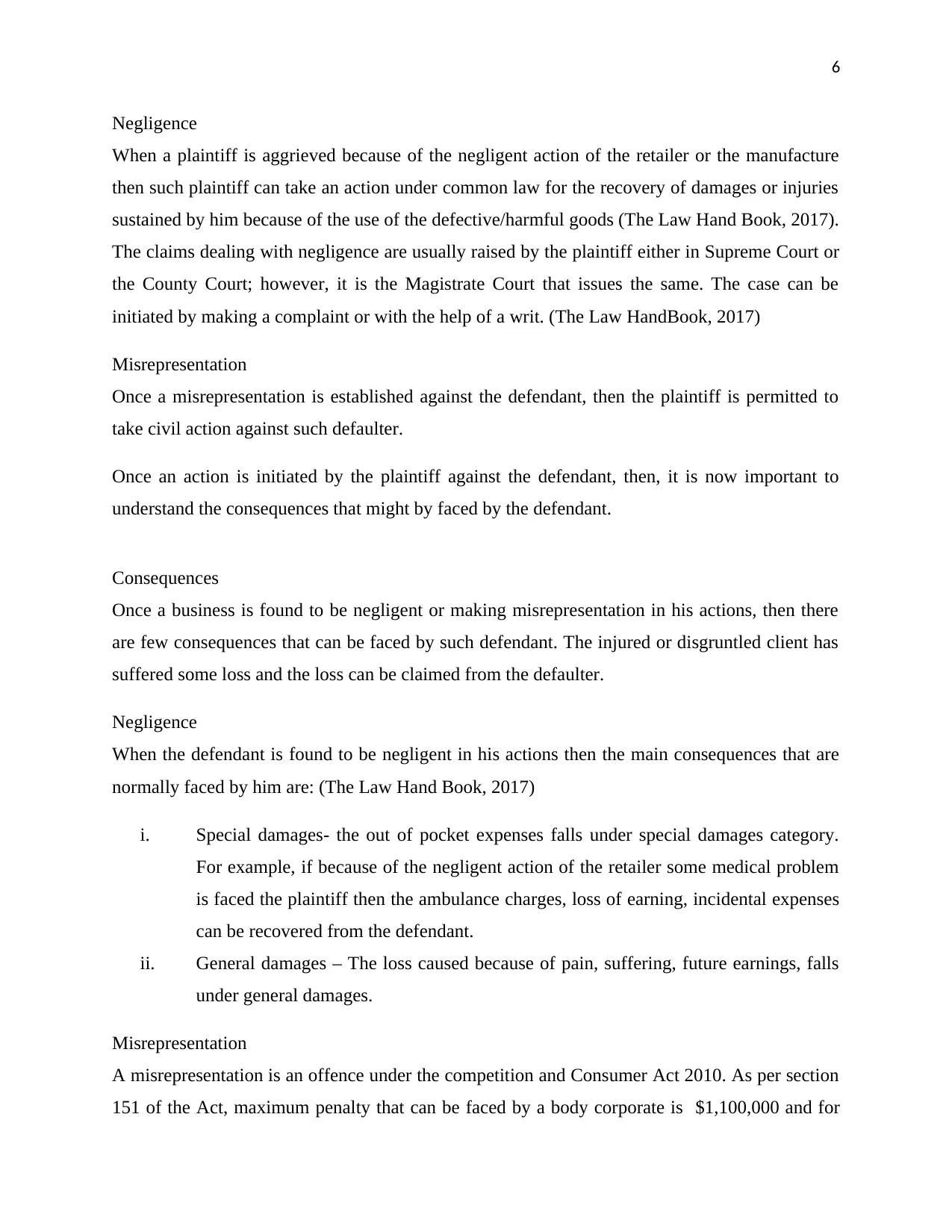
6
Negligence
When a plaintiff is aggrieved because of the negligent action of the retailer or the manufacture
then such plaintiff can take an action under common law for the recovery of damages or injuries
sustained by him because of the use of the defective/harmful goods (The Law Hand Book, 2017).
The claims dealing with negligence are usually raised by the plaintiff either in Supreme Court or
the County Court; however, it is the Magistrate Court that issues the same. The case can be
initiated by making a complaint or with the help of a writ. (The Law HandBook, 2017)
Misrepresentation
Once a misrepresentation is established against the defendant, then the plaintiff is permitted to
take civil action against such defaulter.
Once an action is initiated by the plaintiff against the defendant, then, it is now important to
understand the consequences that might by faced by the defendant.
Consequences
Once a business is found to be negligent or making misrepresentation in his actions, then there
are few consequences that can be faced by such defendant. The injured or disgruntled client has
suffered some loss and the loss can be claimed from the defaulter.
Negligence
When the defendant is found to be negligent in his actions then the main consequences that are
normally faced by him are: (The Law Hand Book, 2017)
i. Special damages- the out of pocket expenses falls under special damages category.
For example, if because of the negligent action of the retailer some medical problem
is faced the plaintiff then the ambulance charges, loss of earning, incidental expenses
can be recovered from the defendant.
ii. General damages – The loss caused because of pain, suffering, future earnings, falls
under general damages.
Misrepresentation
A misrepresentation is an offence under the competition and Consumer Act 2010. As per section
151 of the Act, maximum penalty that can be faced by a body corporate is $1,100,000 and for
Negligence
When a plaintiff is aggrieved because of the negligent action of the retailer or the manufacture
then such plaintiff can take an action under common law for the recovery of damages or injuries
sustained by him because of the use of the defective/harmful goods (The Law Hand Book, 2017).
The claims dealing with negligence are usually raised by the plaintiff either in Supreme Court or
the County Court; however, it is the Magistrate Court that issues the same. The case can be
initiated by making a complaint or with the help of a writ. (The Law HandBook, 2017)
Misrepresentation
Once a misrepresentation is established against the defendant, then the plaintiff is permitted to
take civil action against such defaulter.
Once an action is initiated by the plaintiff against the defendant, then, it is now important to
understand the consequences that might by faced by the defendant.
Consequences
Once a business is found to be negligent or making misrepresentation in his actions, then there
are few consequences that can be faced by such defendant. The injured or disgruntled client has
suffered some loss and the loss can be claimed from the defaulter.
Negligence
When the defendant is found to be negligent in his actions then the main consequences that are
normally faced by him are: (The Law Hand Book, 2017)
i. Special damages- the out of pocket expenses falls under special damages category.
For example, if because of the negligent action of the retailer some medical problem
is faced the plaintiff then the ambulance charges, loss of earning, incidental expenses
can be recovered from the defendant.
ii. General damages – The loss caused because of pain, suffering, future earnings, falls
under general damages.
Misrepresentation
A misrepresentation is an offence under the competition and Consumer Act 2010. As per section
151 of the Act, maximum penalty that can be faced by a body corporate is $1,100,000 and for
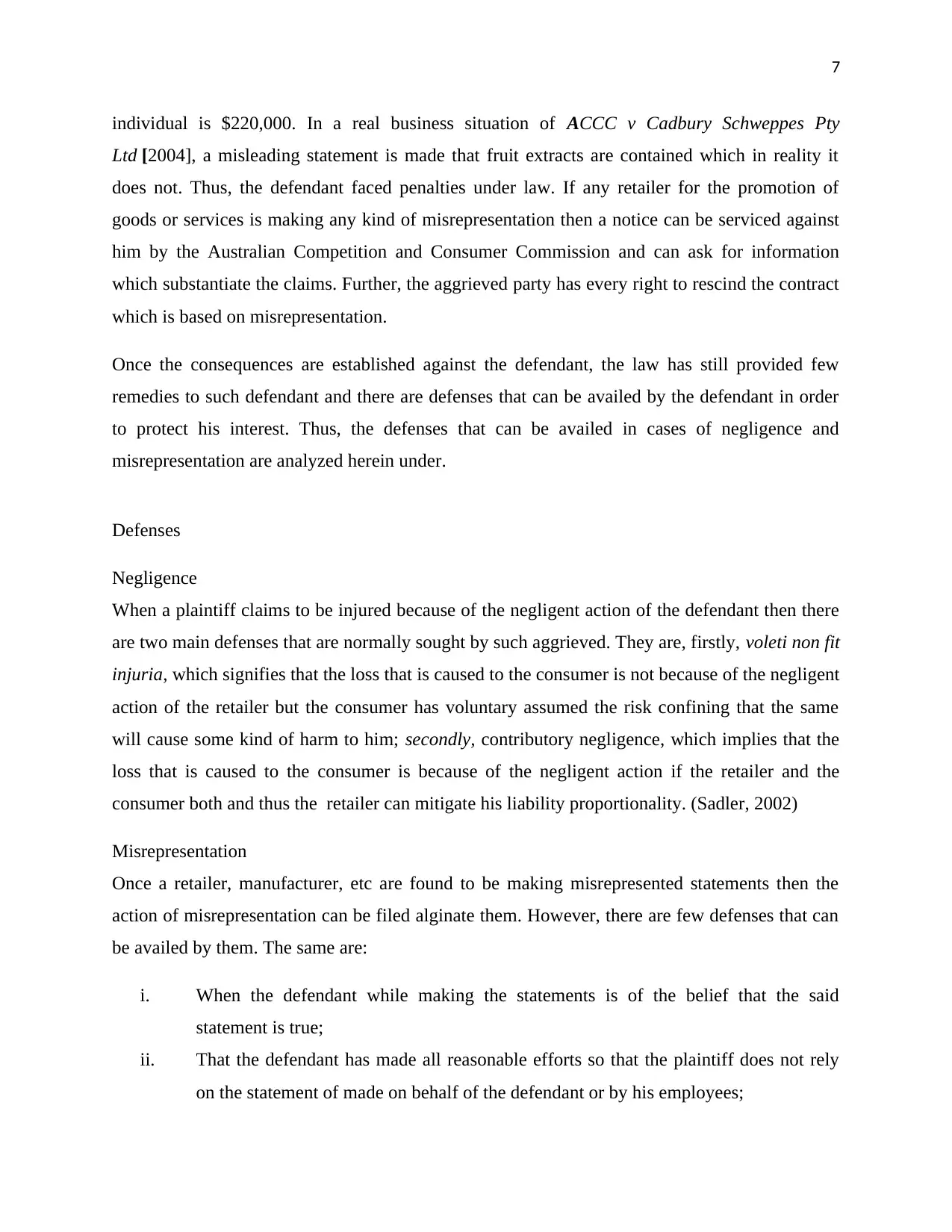
7
individual is $220,000. In a real business situation of ACCC v Cadbury Schweppes Pty
Ltd [2004], a misleading statement is made that fruit extracts are contained which in reality it
does not. Thus, the defendant faced penalties under law. If any retailer for the promotion of
goods or services is making any kind of misrepresentation then a notice can be serviced against
him by the Australian Competition and Consumer Commission and can ask for information
which substantiate the claims. Further, the aggrieved party has every right to rescind the contract
which is based on misrepresentation.
Once the consequences are established against the defendant, the law has still provided few
remedies to such defendant and there are defenses that can be availed by the defendant in order
to protect his interest. Thus, the defenses that can be availed in cases of negligence and
misrepresentation are analyzed herein under.
Defenses
Negligence
When a plaintiff claims to be injured because of the negligent action of the defendant then there
are two main defenses that are normally sought by such aggrieved. They are, firstly, voleti non fit
injuria, which signifies that the loss that is caused to the consumer is not because of the negligent
action of the retailer but the consumer has voluntary assumed the risk confining that the same
will cause some kind of harm to him; secondly, contributory negligence, which implies that the
loss that is caused to the consumer is because of the negligent action if the retailer and the
consumer both and thus the retailer can mitigate his liability proportionality. (Sadler, 2002)
Misrepresentation
Once a retailer, manufacturer, etc are found to be making misrepresented statements then the
action of misrepresentation can be filed alginate them. However, there are few defenses that can
be availed by them. The same are:
i. When the defendant while making the statements is of the belief that the said
statement is true;
ii. That the defendant has made all reasonable efforts so that the plaintiff does not rely
on the statement of made on behalf of the defendant or by his employees;
individual is $220,000. In a real business situation of ACCC v Cadbury Schweppes Pty
Ltd [2004], a misleading statement is made that fruit extracts are contained which in reality it
does not. Thus, the defendant faced penalties under law. If any retailer for the promotion of
goods or services is making any kind of misrepresentation then a notice can be serviced against
him by the Australian Competition and Consumer Commission and can ask for information
which substantiate the claims. Further, the aggrieved party has every right to rescind the contract
which is based on misrepresentation.
Once the consequences are established against the defendant, the law has still provided few
remedies to such defendant and there are defenses that can be availed by the defendant in order
to protect his interest. Thus, the defenses that can be availed in cases of negligence and
misrepresentation are analyzed herein under.
Defenses
Negligence
When a plaintiff claims to be injured because of the negligent action of the defendant then there
are two main defenses that are normally sought by such aggrieved. They are, firstly, voleti non fit
injuria, which signifies that the loss that is caused to the consumer is not because of the negligent
action of the retailer but the consumer has voluntary assumed the risk confining that the same
will cause some kind of harm to him; secondly, contributory negligence, which implies that the
loss that is caused to the consumer is because of the negligent action if the retailer and the
consumer both and thus the retailer can mitigate his liability proportionality. (Sadler, 2002)
Misrepresentation
Once a retailer, manufacturer, etc are found to be making misrepresented statements then the
action of misrepresentation can be filed alginate them. However, there are few defenses that can
be availed by them. The same are:
i. When the defendant while making the statements is of the belief that the said
statement is true;
ii. That the defendant has made all reasonable efforts so that the plaintiff does not rely
on the statement of made on behalf of the defendant or by his employees;
Paraphrase This Document
Need a fresh take? Get an instant paraphrase of this document with our AI Paraphraser
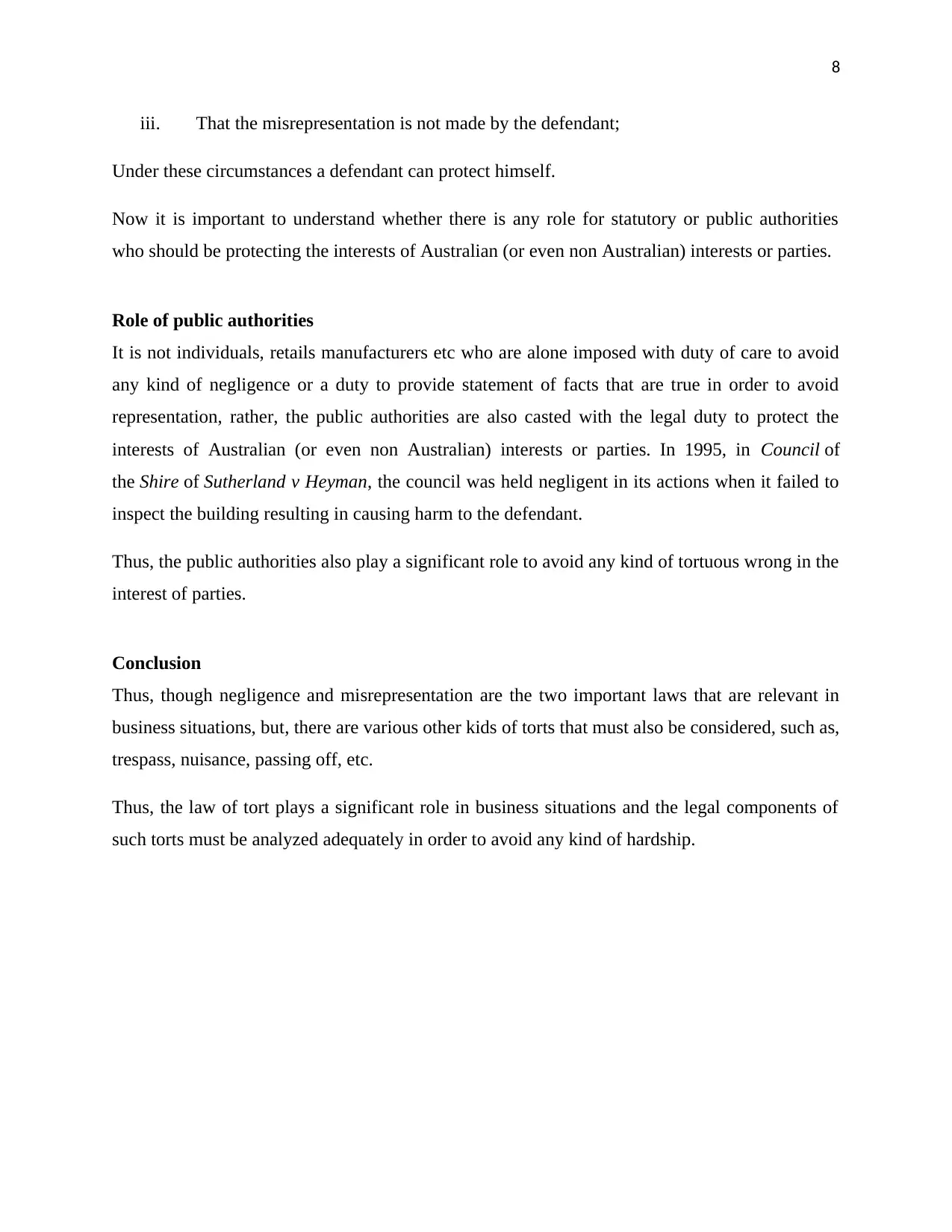
8
iii. That the misrepresentation is not made by the defendant;
Under these circumstances a defendant can protect himself.
Now it is important to understand whether there is any role for statutory or public authorities
who should be protecting the interests of Australian (or even non Australian) interests or parties.
Role of public authorities
It is not individuals, retails manufacturers etc who are alone imposed with duty of care to avoid
any kind of negligence or a duty to provide statement of facts that are true in order to avoid
representation, rather, the public authorities are also casted with the legal duty to protect the
interests of Australian (or even non Australian) interests or parties. In 1995, in Council of
the Shire of Sutherland v Heyman, the council was held negligent in its actions when it failed to
inspect the building resulting in causing harm to the defendant.
Thus, the public authorities also play a significant role to avoid any kind of tortuous wrong in the
interest of parties.
Conclusion
Thus, though negligence and misrepresentation are the two important laws that are relevant in
business situations, but, there are various other kids of torts that must also be considered, such as,
trespass, nuisance, passing off, etc.
Thus, the law of tort plays a significant role in business situations and the legal components of
such torts must be analyzed adequately in order to avoid any kind of hardship.
iii. That the misrepresentation is not made by the defendant;
Under these circumstances a defendant can protect himself.
Now it is important to understand whether there is any role for statutory or public authorities
who should be protecting the interests of Australian (or even non Australian) interests or parties.
Role of public authorities
It is not individuals, retails manufacturers etc who are alone imposed with duty of care to avoid
any kind of negligence or a duty to provide statement of facts that are true in order to avoid
representation, rather, the public authorities are also casted with the legal duty to protect the
interests of Australian (or even non Australian) interests or parties. In 1995, in Council of
the Shire of Sutherland v Heyman, the council was held negligent in its actions when it failed to
inspect the building resulting in causing harm to the defendant.
Thus, the public authorities also play a significant role to avoid any kind of tortuous wrong in the
interest of parties.
Conclusion
Thus, though negligence and misrepresentation are the two important laws that are relevant in
business situations, but, there are various other kids of torts that must also be considered, such as,
trespass, nuisance, passing off, etc.
Thus, the law of tort plays a significant role in business situations and the legal components of
such torts must be analyzed adequately in order to avoid any kind of hardship.
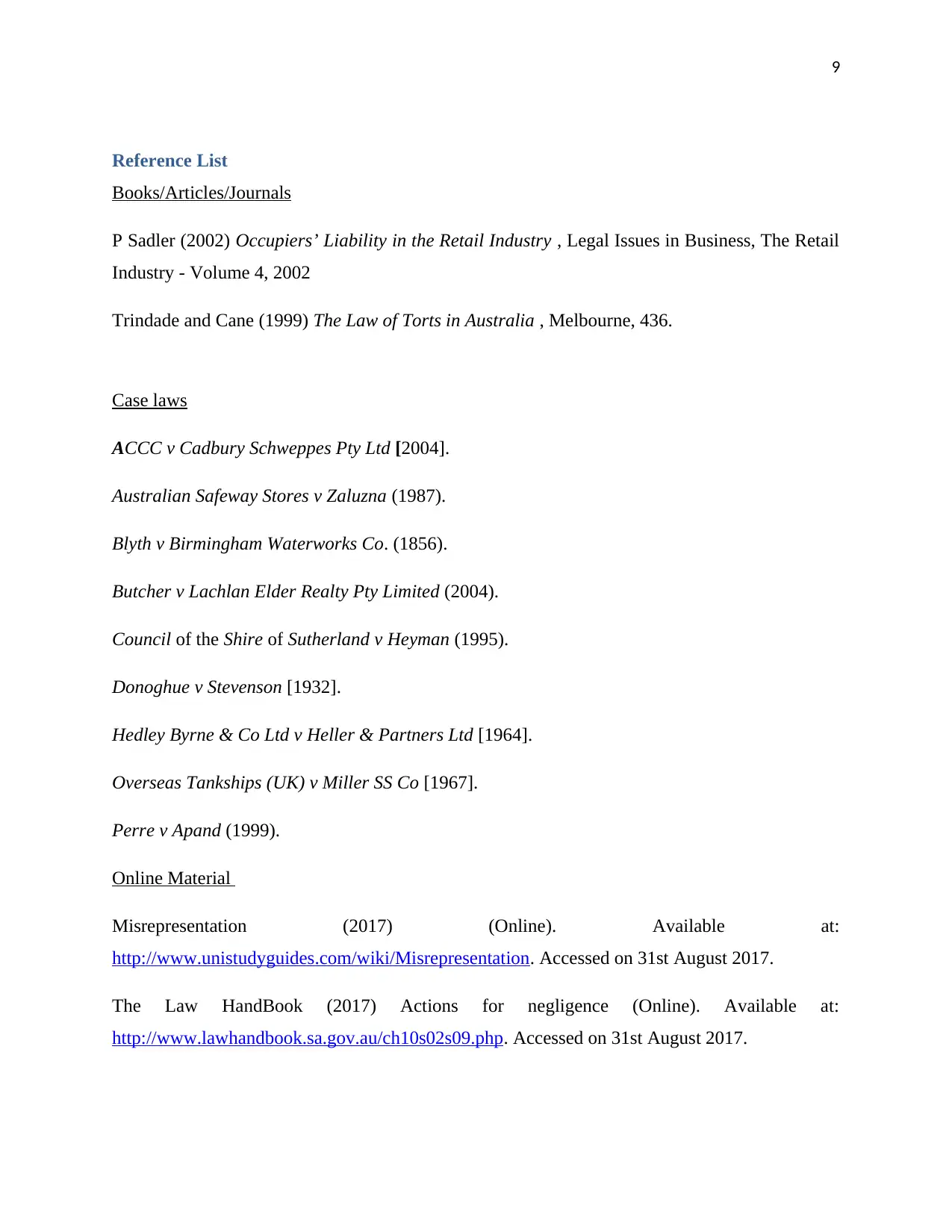
9
Reference List
Books/Articles/Journals
P Sadler (2002) Occupiers’ Liability in the Retail Industry , Legal Issues in Business, The Retail
Industry - Volume 4, 2002
Trindade and Cane (1999) The Law of Torts in Australia , Melbourne, 436.
Case laws
ACCC v Cadbury Schweppes Pty Ltd [2004].
Australian Safeway Stores v Zaluzna (1987).
Blyth v Birmingham Waterworks Co. (1856).
Butcher v Lachlan Elder Realty Pty Limited (2004).
Council of the Shire of Sutherland v Heyman (1995).
Donoghue v Stevenson [1932].
Hedley Byrne & Co Ltd v Heller & Partners Ltd [1964].
Overseas Tankships (UK) v Miller SS Co [1967].
Perre v Apand (1999).
Online Material
Misrepresentation (2017) (Online). Available at:
http://www.unistudyguides.com/wiki/Misrepresentation. Accessed on 31st August 2017.
The Law HandBook (2017) Actions for negligence (Online). Available at:
http://www.lawhandbook.sa.gov.au/ch10s02s09.php. Accessed on 31st August 2017.
Reference List
Books/Articles/Journals
P Sadler (2002) Occupiers’ Liability in the Retail Industry , Legal Issues in Business, The Retail
Industry - Volume 4, 2002
Trindade and Cane (1999) The Law of Torts in Australia , Melbourne, 436.
Case laws
ACCC v Cadbury Schweppes Pty Ltd [2004].
Australian Safeway Stores v Zaluzna (1987).
Blyth v Birmingham Waterworks Co. (1856).
Butcher v Lachlan Elder Realty Pty Limited (2004).
Council of the Shire of Sutherland v Heyman (1995).
Donoghue v Stevenson [1932].
Hedley Byrne & Co Ltd v Heller & Partners Ltd [1964].
Overseas Tankships (UK) v Miller SS Co [1967].
Perre v Apand (1999).
Online Material
Misrepresentation (2017) (Online). Available at:
http://www.unistudyguides.com/wiki/Misrepresentation. Accessed on 31st August 2017.
The Law HandBook (2017) Actions for negligence (Online). Available at:
http://www.lawhandbook.sa.gov.au/ch10s02s09.php. Accessed on 31st August 2017.
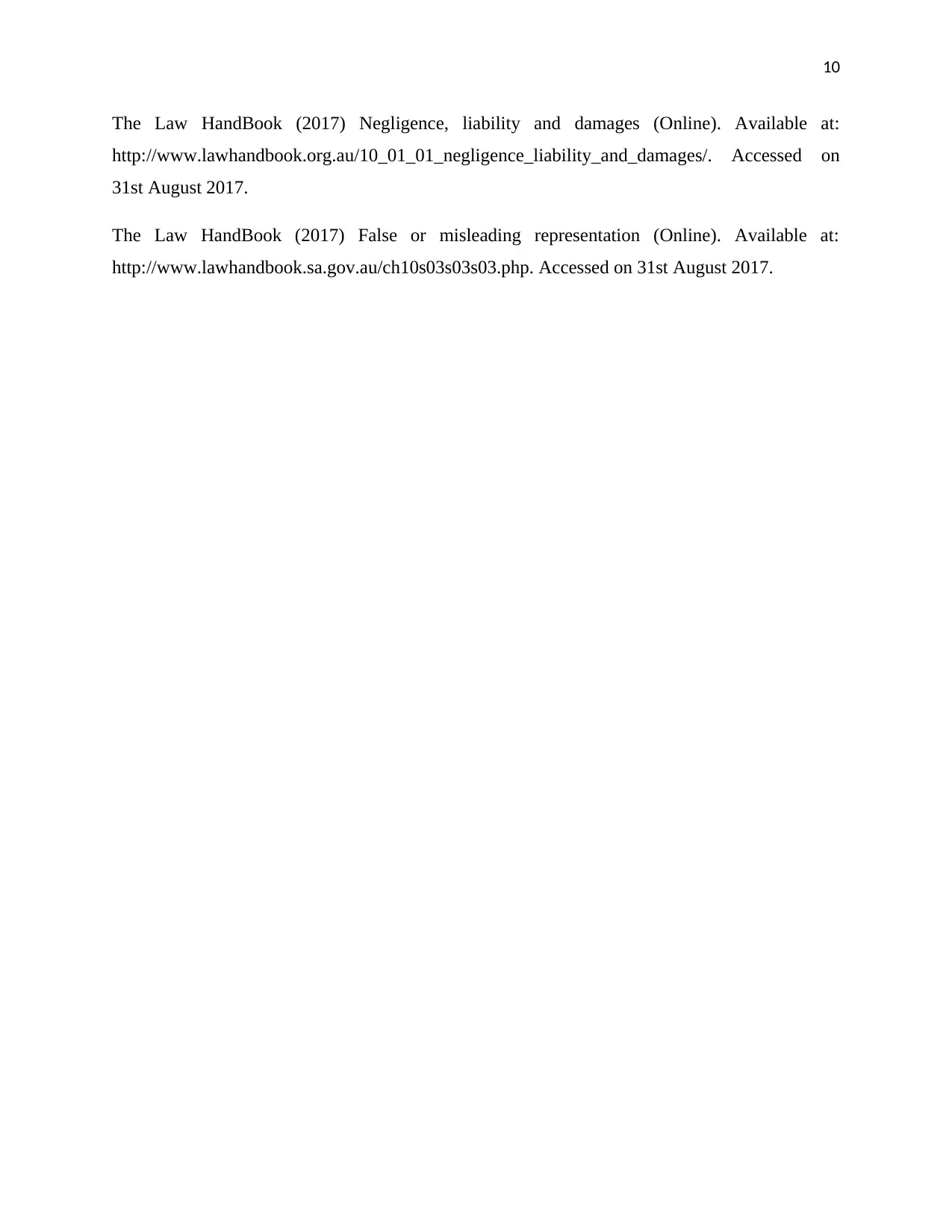
10
The Law HandBook (2017) Negligence, liability and damages (Online). Available at:
http://www.lawhandbook.org.au/10_01_01_negligence_liability_and_damages/. Accessed on
31st August 2017.
The Law HandBook (2017) False or misleading representation (Online). Available at:
http://www.lawhandbook.sa.gov.au/ch10s03s03s03.php. Accessed on 31st August 2017.
The Law HandBook (2017) Negligence, liability and damages (Online). Available at:
http://www.lawhandbook.org.au/10_01_01_negligence_liability_and_damages/. Accessed on
31st August 2017.
The Law HandBook (2017) False or misleading representation (Online). Available at:
http://www.lawhandbook.sa.gov.au/ch10s03s03s03.php. Accessed on 31st August 2017.
1 out of 10
Related Documents
Your All-in-One AI-Powered Toolkit for Academic Success.
+13062052269
info@desklib.com
Available 24*7 on WhatsApp / Email
![[object Object]](/_next/static/media/star-bottom.7253800d.svg)
Unlock your academic potential
© 2024 | Zucol Services PVT LTD | All rights reserved.





